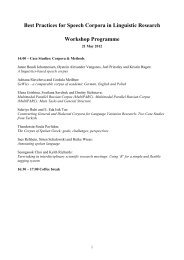96 • 2011 - Hamburger Zentrum für Sprachkorpora - Universität ...
96 • 2011 - Hamburger Zentrum für Sprachkorpora - Universität ...
96 • 2011 - Hamburger Zentrum für Sprachkorpora - Universität ...
Create successful ePaper yourself
Turn your PDF publications into a flip-book with our unique Google optimized e-Paper software.
sentences for a given LU; (3) A lexical entry report<br />
which summarizes the syntactic realization of the FEs<br />
and the valence patterns of the LU in two separate tables<br />
(see Fillmore et al., 2003B; Fillmore, 2007).<br />
Figure 1 above illustrates an excerpt from the valence<br />
patterns in the lexical report of steal in the Theft<br />
frame. The column on the far left lists the number of<br />
annotated example sentences (in the annotation report)<br />
illustrating the individual valence patterns. The rows<br />
represent so-called frame element configurations<br />
together with their syntactic realizations in terms of<br />
phrase type and grammatical function. For example, the<br />
third frame element configuration from the top lists the<br />
FEs GOODS, MANNER, and PERPETRATOR. The GOODS are<br />
realized syntactically as a NP Object, the MANNER as a<br />
dependent ADVP, and the PERPETRATOR as an external NP.<br />
Such systematic valence tables allow researchers to gain<br />
a better understanding of how the semantics of frames<br />
are realized syntactically. 5<br />
3. FrameNets for other languages<br />
3.1. Similarities and differences<br />
Following the success of the Berkeley FrameNet for<br />
English, a number of FrameNets for other languages<br />
were developed over the past ten years. Based on ideas<br />
outlined in Heid (19<strong>96</strong>), Fontenelle (1997), and Boas<br />
(2001/2002/2005a), researchers aimed to create parallel<br />
FrameNets by re-using frames constructed by the<br />
Berkeley FrameNet project for English. While<br />
FrameNets for other languages aim to re-use English<br />
FrameNet frames to the greatest extent possible, they<br />
differ in a number of important points from the original<br />
FrameNet (see Boas, 2009).<br />
For example, projects such as SALSA (Burchardt et al.,<br />
2009) aim to create full-text annotation of an entire<br />
German corpus instead of finding isolated corpus<br />
sentences to identify lexicographically relevant<br />
information as is the case with the Berkeley FrameNet<br />
and Spanish FrameNet (Subirats, 2009). FrameNets for<br />
other languages also differ in what types of resources<br />
5 For details about the different phrase types and grammatical<br />
functions, including the different types of null instantiation<br />
(CNI, DNI, and INI) (Fillmore 1986), see Fillmore et al.<br />
2003b, Boas 2009, Fillmore & Baker 2010, and Ruppenhofer<br />
et al. 2010.<br />
Multilingual Resources and Multilingual Applications - Invited Talks<br />
they use as data pools. That is, besides exploiting a<br />
monolingual corpus as is the case with Japanese<br />
FrameNet (Ohara, 2009) or Hebrew FrameNet (Petruck,<br />
2009), projects such as French FrameNet (Pitel, 2009) or<br />
BiFrameNet (Fung & Chen, 2004) also employ multilingual<br />
corpora and other existing lexical resources.<br />
Another difference concerns the tools used for data<br />
extraction and annotation. While the Japanese and<br />
Spanish FrameNets adopted the Berkeley FrameNet<br />
software (Baker et al., 2003) with slight modifications,<br />
other projects such as SALSA developed their own tools<br />
to conduct semi-automatic annotation on top of existing<br />
syntactic annotations found in the TIGER corpus, or<br />
they integrate off-the shelf software as is the case with<br />
French FrameNet or Hebrew FrameNet. FrameNets for<br />
other languages also differ in the methodology used to<br />
produce parallel lexicon fragments. While German<br />
FrameNet (Boas, 2002) and Japanese FrameNet (Ohara,<br />
2009) rely on manual annotations, French FrameNet and<br />
BiFrameNet use semi-automatic and automatic<br />
approaches to create parallel lexicon fragments for<br />
French and Chinese. Finally, FrameNets for other<br />
languages also differ in their semantic domains and the<br />
goals they pursue. While most non-English FrameNets<br />
aim to create databases with broad coverage, other<br />
projects focus on specific lexical domains such as<br />
football (a.k.a. soccer) language (Schmidt, 2009) or the<br />
language of criminal justice (Bertoldi et al., 2010).<br />
Finally, while the data from almost all non-English<br />
FrameNets are intended to be used by a variety of<br />
audiences, Multi FrameNet6 is intended to support<br />
vocabulary acquisition in the foreign language<br />
classroom (see Atzler, <strong>2011</strong>).<br />
3.2. Re-using (English) semantic frames<br />
To exemplify how English FrameNet frames can be reused<br />
for the creation of parallel lexicon fragments<br />
consider Boas' (2005a) discussion of the English verb<br />
answer evoking the Communication_Response<br />
frame and its counterpart responder in Spanish<br />
FrameNet. The basic idea is that since the two verbs are<br />
translation equivalents they should evoke the same<br />
semantic frame, which should in turn be used as a<br />
common structuring device for combining the respective<br />
6 http://www.coerll.utexas.edu/coerll/taxonomy/term/627<br />
11



